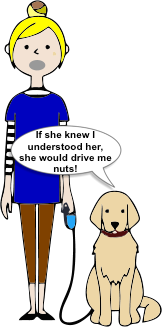Can Our Dogs Understand Our Language?
We often teach dogs to obey verbal commands, like sit, stay, roll over, etc. But how much of human language do they understand? And do they perceive words differently from other sounds?
Recent research suggests that they do and that dogs can differentiate between different languages and between real words and gibberish.
Everyone knows that dogs are pretty special when it comes to how interested they are in humans and how they interact with us.
- But how much can they capture the subtleties of the language coming out of our mouths? Do they perceive it distinctly as speech, as opposed to other sounds reaching their ears? Are they processing what we are saying even when we do not say their favorite words? A study recent published in NeuroImage suggests they are.
The Idea for the Study
Two neuroscientists moved from Mexico to Budapest with their two border collies and one cat. When they realized how different it was to be surrounded by people speaking Hungarian instead of their native Spanish, they wondered if their canine companions had noticed this as well.
Both scientists were working in a research group at a University in Hungary that studies the evolution of speech perception in mammals, including dogs, with tools such as functional magnetic resonance imaging (fMRI), which monitors changes in brain blood flow. More blood flowing to a specific region of the brain means more activation—allowing researchers to glimpse changes in brain activity in response to certain stimuli.
The university group had already showed that dogs activate different neural pathways to recognize the meaning of words than they do to sense changes in emotional intonation. But no one knew whether the animals could distinguish actual human speech from slightly different sounds that did not constitute a long string of words. And no one knew whether a dog could pick up when a person was speaking a different language.
The Study
- The researchers recruited 18 family dogs, including their own border collies who had come from Mexico. The dogs were familiar with either Hungarian or Spanish but not both—and they had been previously trained to lie still in an fMRI machine. Through a pair of noise-canceling headphones, the dogs heard passages from Antoine de Saint-Exupéry’s The Little Prince in either Spanish or Hungarian.
- From the fMRI scans, the researchers saw the same areas of the brain light up but with different activation patterns, depending on whether the dogs were hearing the story in their native language or a new one—suggesting that they were neurologically processing differences between the two languages.
- They then tested for specific differences in intonation or emphasis on certain syllables to note any differences
- Again, the team saw different patterns in brain activity when a dog heard real human speech instead of speechlike gibberish
- There was no change in brain activity between hearing Spanish gibberish versus Hungarian gibberish, however, implying that the canines’ brain was not just responding to the different tonal qualities.
A lot of people just assume that when we talk, dogs are just hearing ‘blah blah blah.
- The study shows that they are actually picking up on our speech rhythms and how we sound when we speak a language.
- Altogether the study shows that the brains of dogs can detect a difference between speech and speechlike sounds and can even tell apart different human languages. “This is the first time we’ve demonstrated that a nonhuman brain can distinguish language,” according to the researchers, noting that while other animals can be trained to hear a difference between human languages, the dogs were able to do it without explicit training.
“Dog brains, like human brains, can distinguish between speech and non-speech.
“This study showed for the first time that a non-human brain can distinguish between two languages.
In addition to speech detection, dog brains could also distinguish between Spanish and Hungarian.
Although future experiments are necessary to parse whether dogs have brain regions dedicated to detecting changes in human speech that were honed over eons of spending time with humans or whether their ability represents more general auditory pattern recognition.
The scientists note that even though many animals are capable of auditory pattern recognition, dogs are unique for their persistent interest in humans. “The wonderful thing about dogs is they want to cooperate. They want to understand us.”
Many pet parents will swear that their furry family member(s) knows what they are saying. Common phrases overheard by dog parents include, ‘go potty’, ‘get the ball”, “where is your fuzzy”, “sit”, “stay”, “come”, etc. Many handlers have dazzled viewers in an Agility ring by calling out the names of the obstacles to go to next, e.g. “tunnel”, “weave”, “table” and a few even take it to the limit with calls like “left tunnel” or “right jump.”
See how many words you believe dog understands!
